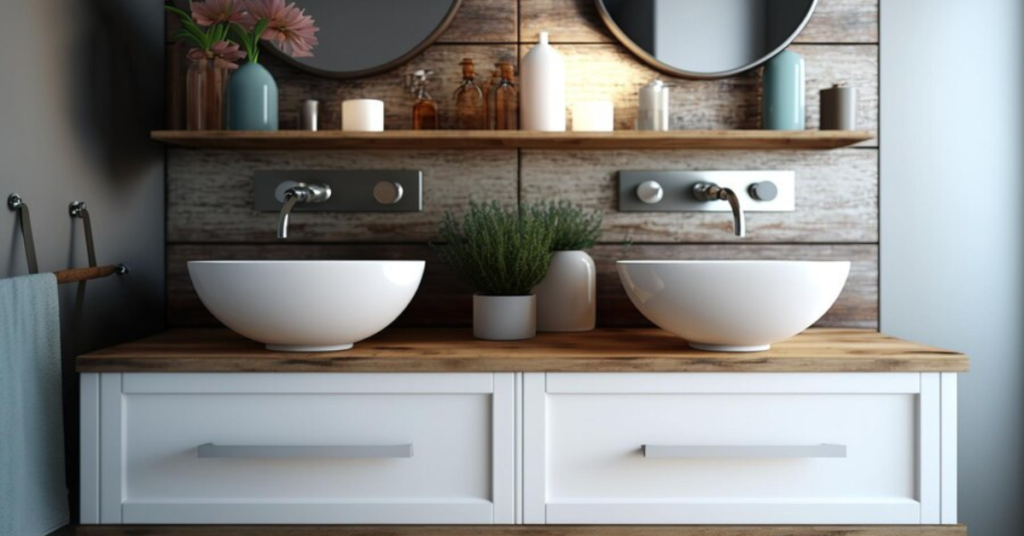In the realm of bathroom design and functionality, one of the most important fixtures is undoubtedly the vanity. A bathroom vanity serves both practical and aesthetic purposes, providing storage space, countertop surface, and often acting as a focal point in the room’s design. Whether you’re renovating a bathroom or building a new one, choosing the right vanity is essential. In this comprehensive guide, we’ll delve into everything you need to know about bathroom vanities, including their types, styles, materials, sizing considerations, installation tips and more.
Understanding Bathroom Vanities
A bathroom vanity is a combination of a sink or basin and a storage cabinet or countertop. It typically sits at waist height and serves as a functional and decorative element in the bathroom. Vanities come in a variety of styles, sizes, and configurations to suit different needs and preferences.
Types of Bathroom Vanities
Freestanding Vanities: These are standalone units that rest on the floor and are not attached to the wall. Freestanding vanities offer flexibility in terms of placement and are available in various styles, from traditional to modern.
Wall-Mounted Vanities: Also known as floating vanities, these are attached directly to the wall, creating a sleek and modern look. Wall-mounted vanities are ideal for smaller bathrooms or for creating a more spacious feel.
Vessel Sink Vanities: Vessel sinks sit on top of the vanity countertop rather than being recessed. This style adds a contemporary touch to the bathroom and allows for more creativity in design.
Pedestal Vanities: Pedestal sinks consist of a basin supported by a single pedestal, offering a minimalist look and maximizing floor space. While they lack storage, pedestal sinks are popular in powder rooms and smaller bathrooms.
Corner Vanities: Designed to fit into corners, these vanities are space-saving solutions for bathrooms with limited square footage. They typically feature a triangular or L-shaped design to maximize storage and countertop space.
Styles and Designs
When it comes to styles and designs, bathroom vanities are available in a wide range of options to complement any décor scheme. Some popular styles include:
Traditional: Characterized by ornate details, decorative hardware, and rich finishes such as cherry or mahogany, traditional vanities exude elegance and sophistication.
Modern: Clean lines, minimalist hardware, and sleek finishes like matte black or glossy white define modern vanities. They are perfect for contemporary or minimalist bathrooms.
Transitional: Combining elements of both traditional and modern styles, transitional vanities offer a timeless look that can adapt to changing trends.
Rustic: Featuring natural wood finishes, distressed textures, and rustic hardware, rustic vanities add warmth and charm to any bathroom, particularly in farmhouse or cottage-style spaces.
Mid-Century: Inspired by the design aesthetics of the mid-20th century, mid-century vanities feature geometric shapes, tapered legs, and bold colors for a retro vibe.
Considerations for Selection
Size and Layout: Measure the available space in your bathroom to determine the appropriate size and configuration for your vanity. Consider factors such as door swings, clearance for drawers and cabinets, and the location of plumbing fixtures.
Storage Needs: Assess your storage requirements based on the number of users and the items you need to store. Opt for vanities with ample drawer space, shelves, or cabinets to keep toiletries, towels, and other essentials organized.
Sink Style: Choose between undermount, drop-in, or vessel sinks based on your preferences and the overall aesthetic of your bathroom. Consider the size and shape of the sink to ensure it fits comfortably within the vanity countertop.
Material and Finish: Select a material and finish that complements your bathroom décor and withstands the rigors of daily use. Common options include wood, laminate, glass, marble, granite, and quartz, each offering unique benefits in terms of durability, maintenance, and aesthetics.
Budget: Set a budget for your vanity project and explore options within your price range. Keep in mind that factors such as material, size, and brand can affect the cost of a vanity.
Popular Materials for Bathroom Vanities
Wood: Solid wood vanities, such as oak, maple, or walnut, are durable and offer a timeless appeal. They can be stained or painted to match any décor style and are available in various finishes.
MDF (Medium-Density Fiberboard): MDF vanities are budget-friendly options that offer stability and resistance to moisture. They can be finished with laminate, veneer, or paint for a polished look.
Engineered Stone: Materials like quartz and solid surface are non-porous and highly resistant to stains, scratches, and moisture. They come in a wide range of colors and patterns and require minimal maintenance.
Glass: Glass vanities create a sleek and modern look while reflecting light to brighten up the bathroom. They are available in clear, frosted, or colored glass options and can be paired with metal or wood accents for added visual interest.
Metal: Stainless steel or brushed nickel vanities add an industrial or contemporary touch to the bathroom. They are durable, easy to clean, and resistant to corrosion, making them suitable for high-moisture environments.
Installation Process
Prepare the Space: Clear out the area where the vanity will be installed and ensure there is adequate space for plumbing connections and electrical outlets if needed.
Assemble the Vanity: Follow the manufacturer’s instructions to assemble the vanity components, including attaching the sink, faucet, and hardware.
Secure to Wall: If installing a wall-mounted vanity, use wall anchors or mounting brackets to secure it in place. Make sure it is level before attaching it to the wall.
Connect Plumbing: Install the P-trap, drain, and water supply lines according to local building codes and manufacturer guidelines. Test for leaks before completing the installation.
Finish with Caulking: Apply silicone caulk around the edges of the sink and countertop to create a watertight seal and prevent water damage.
Maintenance Guidelines
Clean Regularly: Wipe down the vanity surfaces with a mild detergent and water solution or a non-abrasive cleaner to remove dirt, grime, and soap residue.
Avoid Harsh Chemicals: Avoid using abrasive cleaners, bleach, or ammonia-based products, as they can damage the finish or sealant of the vanity.
Protect Against Water Damage: Use coasters or trays to prevent water rings and stains from toiletries or cosmetics. Promptly wipe up any spills or splashes to avoid water damage.
Check for Leaks: Periodically inspect the plumbing connections and seals for signs of leaks or damage. Repair any issues promptly to prevent water damage to the vanity and surrounding areas.
Maintain Hardware: Tighten loose knobs, handles, or hinges as needed to ensure smooth operation and prevent damage to the vanity components.
Conclusion
A well-chosen bathroom vanity can enhance the functionality and aesthetics of your bathroom while reflecting your personal style and preferences. By considering factors such as size, style, material, and maintenance requirements, you can select the perfect vanity for your space. Whether you prefer a traditional, modern, or rustic look, there are countless options available to suit every taste and budget. With proper installation and maintenance, your bathroom vanity will continue to serve you well for years to come, adding value and beauty to your home.







